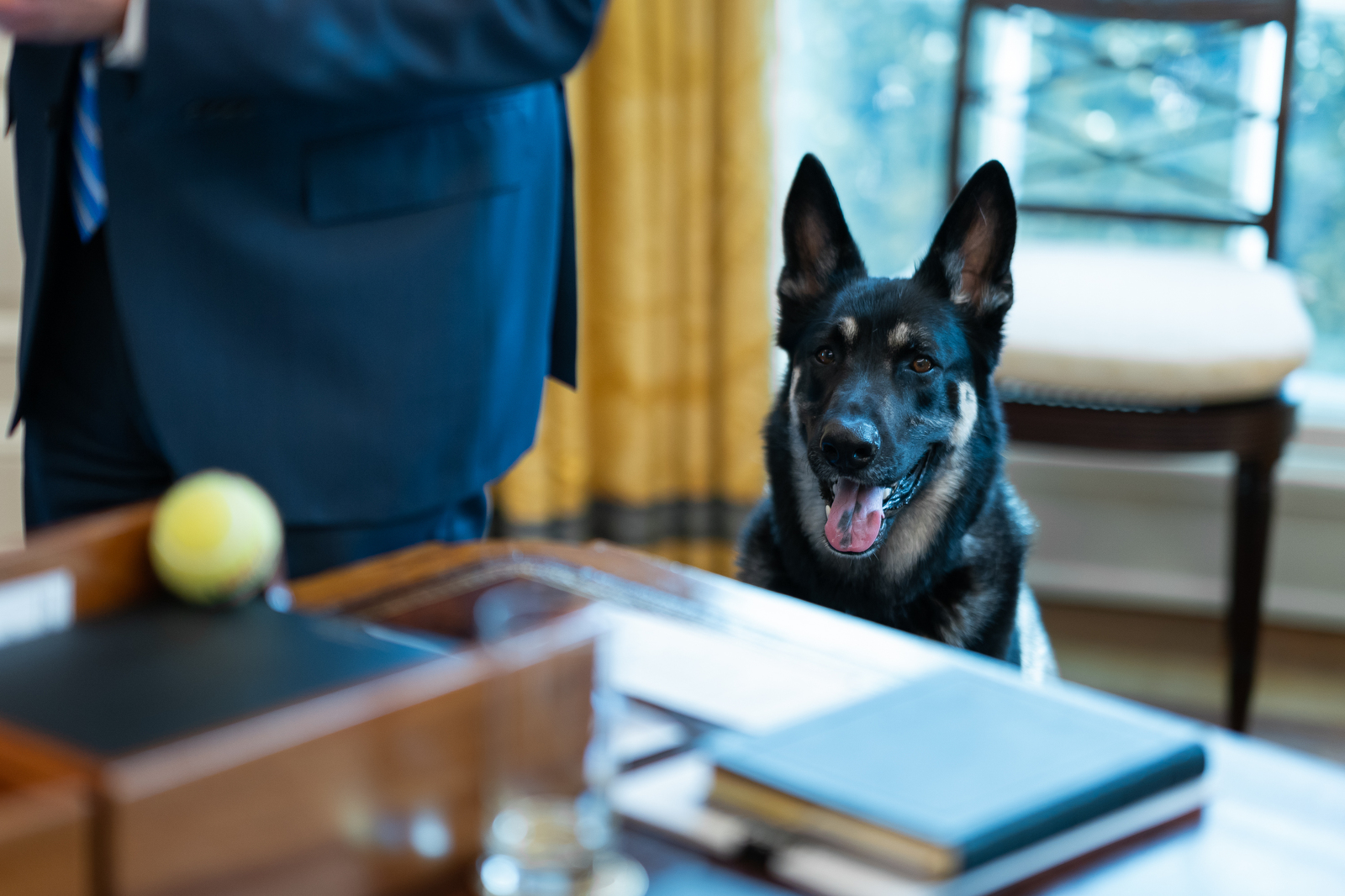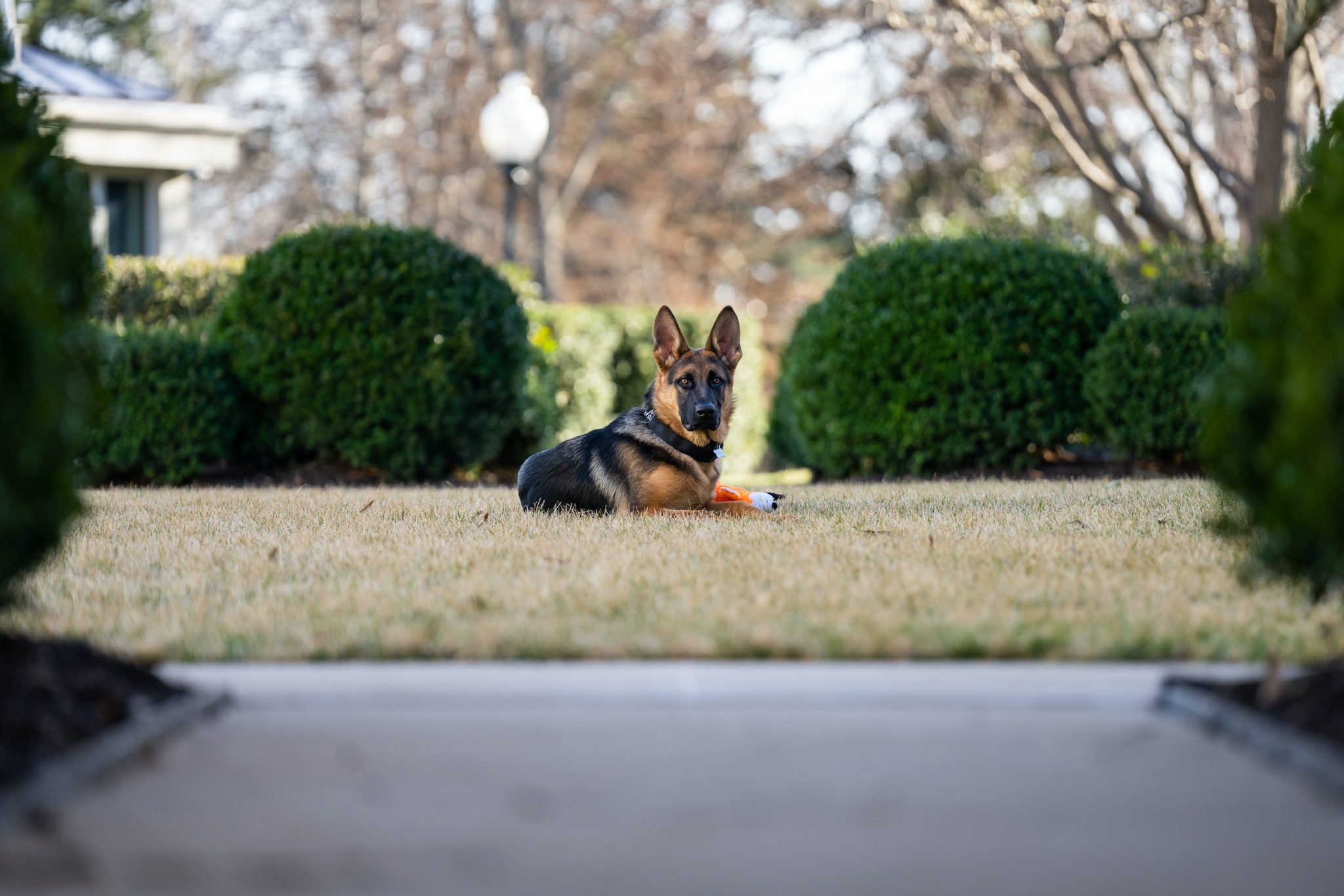Update: Commander is no longer living in the White House, according to an October 4 report.
President Joe Biden’s two-year-old German Shepherd, Commander, has reportedly bitten another Secret Service agent at the White House. The incident, which happened last week, marks the 11th time Commander has nipped an officer since October 2022. One agent had to go to the hospital after an attack last November.
After the watchdog group (no pun intended) Judicial Watch uncovered emails about some of the incidents in July, Jill Biden’s communications director Elizabeth Alexander shared that the family was “partnering with the Secret Service and Executive Residence staff on additional leashing protocols and training.” In a recent statement to Washingtonian, Alexander said, “The White House can be a stressful environment for family pets, and the First Family continues to work on ways to help Commander handle the often unpredictable nature of the White House grounds.”
If this were a civilian’s dog, rather than a FDOTUS, we’d likely be telling a different story. While DC doesn’t have an explicit bite-threshold for deeming a dog dangerous, one trainer we spoke with said she doesn’t “know any dog that’s bitten 11 times and is still with us.” (The Humane Rescue Alliance declined to comment on the matter, stating they “don’t have jurisdiction over federal property.”)
Commander was welcomed to 1600 Pennsylvania Avenue as a three-month-old puppy in December 2021. He’s not the first Biden shepherd with a biting habit—the. Bidens’ other dog, Major, was rehomed in 2021. It’s also unclear why Commander has remained in residence at the White House while his brother was removed after only a few incidents.

Among the professionals we spoke with was certified dog trainer Carla Blackmon at FurEver Family in Woodbridge, Virginia. We asked Blackmon how the hustle and bustle of the White House may be impacting Commander’s behavior, and what kind of training and treatment she would suggest. The good news, says Blackmon: It isn’t too late for two-year-old Commander to adapt and thrive.
What are some potential reasons that Commander might be stressed in his current environment at the White House?
With an individual pet dog, the typical environment is usually a smaller household with a more set schedule and usually two to five people who are around the dog on a regular basis. But when you put them into an environment that has a lot more unknowns, it becomes a bigger stressor.
I don’t think [Commander] has ever been given the opportunity to learn to be comfortable with himself and the environment. And it’s a very large environment to have to learn quickly. He’s around many different security details, the Secret Service, military police, and aides, and these are all people who change on a regular basis. And on top of that, there’s likely inconsistency between how they are interacting with this dog.
I don’t know what type of training they’ve been doing. But if he’s being trained in a way that’s not going to be helpful for him, or safe, or allowing him to learn any kind of confidence or comfort, then there’s always going to be the potential for him to lash out at something.
So, like you said, we don’t know what kind of training he’s been exposed to so far. But let’s say he was starting from scratch—how difficult would it be to train him as a two-year-old dog?
At the age he’s at right now, he can always get more training. I think the key would be for him especially to get more positive reinforcement training, specifically working on building his own confidence in the sense that he’s able to make choices and understand that he has autonomy.
At the same time, as a trainer, if I come across a dog who has bitten somebody 11 times my first question is, have you talked to the veterinarian or veterinary behaviorist? We have several really good behaviorists in this area that could help them figure out better things to do for this dog so that he could be successful, rather than putting him back in the same situations that are causing concern for him.
In your opinion as a trainer, at what point is a dog too dangerous to be around people?
It depends on the severity of the bite(s), along with the ability for the family to address the issue. When I see a dog that is a concern for the family and the community because of their bite history, that’s when I refer them to an animal behaviorist. They’re the ones who are going to be able to look at the whole dog and say, do we have a situation where this family can hold onto the dog and give them a life that is successful knowing certain environments are not helpful for them? Or, is this something that, unfortunately, because of the way the dog presents itself medically or mentally, something else needs to be done?
There are a couple of sanctuaries that will take dogs and allow them a space to live comfortably knowing that they’re just not a social dog.
Can you touch on how exactly veterinary behaviorists are able to identify what the issue is? What’s that process like?
Usually what happens is, you’ll go do a consultation and they will get a full history [including] vaccine history and medical history. One of the main things behaviorists do is observe the dog’s interactions with the humans within their space. From there, you can start a training plan with the behaviorist and, if necessary, use medication to help with the learning process.
I think the one thing that we always have to remember about our dogs is that they all have their own personality and they all need to be given the opportunity to learn to be comfortable and safe in their environment. If they haven’t been given that time, there’s always the potential for some things to be uncomfortable, which ends in barks and bites and growls because that’s the way that they let people know they’re uncomfortable.
And of course the occurrence of uncomfortable environments could be exacerbated by being the president’s dog.
Definitely, and it’s a busy place. He really probably should have a full-time handler, someone who is present for his daily interactions and could train him through everything. That way he can learn that there are some places that he can be safe and other places that might be a little bit more uncomfortable, but there should be someone there that can at least help him through that.
*This interview has been edited for length and clarity.


















